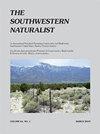SUPPORTING RIPARIAN HABITAT WITH TRADITIONAL IRRIGATION SYSTEMS OF THE NORTHERN RIO GRANDE REGION
IF 0.2
4区 环境科学与生态学
Q4 Agricultural and Biological Sciences
引用次数: 1
Abstract
Abstract We studied the roles of traditional irrigation systems called acequias in supporting riparian habitat in terms of riparian tree planting success. We planted Populus deltoides wislizenii (Rio Grande cottonwood) pole cuttings at locations close to and far from surface water: 1, 2, and 3 m from the edge of an acequia, within 100 m from the river that supplies water to the acequia, and in the middle (lengthwise) of a 500-m-long, 115-m-wide, fallow field between the acequia and the river. The poles were planted at deep and shallow depths. We measured survival and growth at each plot and planting depth after the 2008 and 2009 growing seasons. We hypothesized that the poles planted near the acequia would survive and grow similarly to poles planted near the river. Acequia-related seepage created localized areas where riparian plantings had survival rates >80%. Poles planted by the acequia and river had higher survival rates (>80%) than those in the fallow field (<50%). The deeper plantings led to, on average, 50% more growth than the shallow plantings in terms of height gain, leaf area, number of new shoots, and basal diameter gain. Results from this study show that acequias successfully support cottonwood pole plantings. Resumen Estudiamos el papel de los sistemas de riego tradicionales llamados acequias apoyando el hábitat ribereño en términos del éxito en el establecimiento de árboles plantados. Plantamos esquejes (palos) de Populus deltoides wislizenii (álamo del río Grande) en lugares cercanos y alejados de la superficie del agua: 1, 2 y 3 m de distancia de la orilla de una acequia, dentro de 100 metros del río que alimenta la acequia, y en medio (a lo largo) de un campo no cultivado de 500 metros de longitud y 115 m de ancho, ubicado entre la acequia y el río. Los palos fueron plantados profundos y no profundos en la tierra. Evaluamos la sobrevivencia y crecimiento en cada lugar y profundidad de la siembra después de la temporada de crecimiento en 2008 and 2009. La hipótesis fue que los palos plantados cerca de la acequia sobrevivirían y crecerían de manera similar a los plantados cerca del río. Las filtraciones de la acequia crearon áreas donde la tasa de supervivencia de la siembra ribereña fue >80%. Los palos plantados cerca de la acequia y del río tuvieron mayores tasas de supervivencia (>80%) que los plantados en el campo no cultivado (<50%). Los palos sembrados más profundos resultaron en un promedio de 50% más de crecimiento que los menos profundos, esto en términos de crecimiento de altura, superficie foliar, número de nuevos brotes, y crecimiento de diámetro basal. Los resultados de este estudio muestran que las acequias promueven exitosamente la siembra de palos de álamo.用里奥格兰德北部地区的传统灌溉系统支持河岸栖息地
摘要我们研究了被称为沟渠的传统灌溉系统在支持河岸生境方面的作用,以确保河岸树木的种植成功。我们在靠近地表水和远离地表水的位置种植了Populus deltoides wislizenii(Rio Grande Cottonwood)杆状切口:距离沟渠边缘1、2和3米,距离向沟渠供水的河流100米,在沟渠和河流之间500米长、115米宽的中间(长度方向)。杆子被种植在深部和浅部。我们测量了2008年和2009年生长季节后每个地块和种植深度的生存和生长。我们假设种植在沟渠附近的杆子会存活下来,并与种植在河流附近的杆子相似生长。与沟渠相关的渗漏造成了河岸植物存活率>80%的局部地区。沟渠和河流种植的杆子的成活率(>80%)高于休闲场(80%)。种植在沟渠和河流附近的杆子的成活率(>80%)高于种植在未耕种的田地(<50%)。播得最深的枝条平均比播得最深的枝条长50%,这是在高度生长、叶面积、新芽数量和基径生长方面。这项研究的结果表明,沟渠成功地促进了杨树的种植。
本文章由计算机程序翻译,如有差异,请以英文原文为准。
求助全文
约1分钟内获得全文
求助全文
来源期刊

Southwestern Naturalist
环境科学-生态学
CiteScore
0.50
自引率
50.00%
发文量
47
审稿时长
18-36 weeks
期刊介绍:
The Southwestern Naturalist (a publication of the Southwestern Association of Naturalists since 1953) is an international journal (published quarterly) that reports original and significant research in any field of natural history. This journal promotes the study of plants and animals (living and fossil) in the multinational region that includes the southwestern United States, Mexico, and Central America. Appropriate submission of manuscripts may come from studies conducted in the countries of focus or in regions outside this area that report significant findings relating to biota occurring in the southwestern United States, Mexico, and Central America. Publication is in English, and manuscripts may be feature articles or notes. Feature articles communicate results of completed scientific investigations, while notes are reserved for short communications (e.g., behavioral observations, range extensions, and other important findings that do not in themselves constitute a comprehensive study). All manuscripts (feature articles and notes) require an abstract in both English and Spanish.
 求助内容:
求助内容: 应助结果提醒方式:
应助结果提醒方式:


